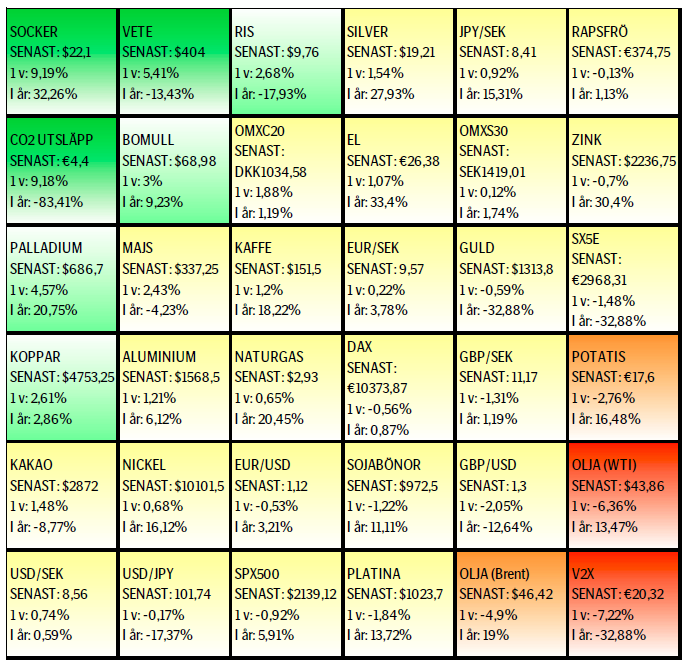Analys
SEB Råvarubrev 20 september 2016

Centralbanker (Bank of Japan & FED) i fokus.
Marknadsoron mätt som Fed’s finansiella stressindex har sedan förra veckan ökat något men ligger fortfarande långt ifrån oroande nivåer. Börsnedgångarna har mer övergått till att intervallhandel, ena dagen upp och andra dagen ned. Obligationsräntorna har dock inte backat många punkter ifrån förra veckans topp vilket vi finner vara ett rätt intressant beteende. Vi kan förvänta oss ett lugn fram tills imorgon (och en ökad volatilitet därefter) när både Bank of Japan och Federal Reserve kommer med sina räntebesked. BoJ förväntas att antagligen utöka köp av ETF, REIT e. dyl. det är dock mer tveksamt om man utökar obligationsköpen då det i nuvarande inköpstakt inte kommer att finnas några statsobligationer kvar på marknaden om cirka tre år. FED förväntas inte göra någonting denna gång heller.
Råvaror: Oljan har tappat något sedan förra veckan men följer i princip det meandrande mönster vi förväntat oss inför det informella OPEC–mötet i Alger den 26-28 sept. Nymex-olja ser ytterligare något svagare ut och vi skulle inte vara helt förvånade att se den ned mot $40/Bbl området (i skrivande stund ligger den på $43). Basmetallerna har alla rört sig något uppåt under senaste veckan med huvudfokus på nickel och den miljörevisionsrapport från Filippinerna som förväntas komma inom kort (gruvstängningar?). Ädelmetaller fortsätter att konsolidera medan jordbruksprodukter som majs och vete har stigit dock från väldigt låga nivåer. Dags för potatisrallyt (botten i juni – toppen i sept. = 62 %) att ta en paus? Förra veckans prisutveckling indikerar att så är fallet. Socker har brutit upp ur sin senaste konsolidering och nått fyra års högsta efter indikationer om ytterligare ökat underskott för nästa år. Vi är lite tveksamma till hållbarheten i detta det senaste rallyt.
Valuta: Dollarn har stärkt på sig sedan förra veckan men lär nu ta en paus till onsdag kväll när FOMC kommer med sitt räntebesked. SEK fortsätter att handla på den svaga sidan (budgeten idag lär inte heller innehålla någon kioskvältare) och förra veckans bubblare, JPY/SEK har nu brutit upp ur sin positiva triangel. NOK/SEK fortsätter också att steg för steg ta sig norrut.
Börser: MSCI världsindex har ännu inte handlats upp till en ny rekordnivå vilket indikerar att innevarande svaghet är temporär. Förra veckans negativa prisutveckling indikerar dock att mer nedgång bör vara att vänta i närtid. MSCI tillväxtmarknadsindex visar också en viss svaghet men lämnade dock ingen veckosignal såsom världsindexet gjorde.
Räntor: Den tyska 10-åringen vände i onsdags åter ned och handlades under fredagen igen till negativ ränta (så länge räntan ligger kvar över -0,13 % finns dock möjligheten till ett nytt försök högre kvar). Amerikanska långräntor (10 & 30år) har dock ett något mer konstruktivt mönster vilket talar för ytterligare uppgång.
OBSERVATIONER I SAMMANDRAG
- Oljepriset handlas nedåt men dock fortfarande i det förväntade intervallet.
- Nickelpriset rycker inför miljöbesked från Filippinerna.
- Guld och silver fortsätter sannolikt att konsolidera.
- USD/SEK fortsätter trycka på för att lämna konsolideringsintervallet.
- Har majs (US) fått fast mark under fötterna?
- OMXS30 nedgången har än så länge utvecklats som en korrektion.
En placering i certifikat och warranter är förknippat med risker. Du kan förlora hela ditt investerade kapital. Läs mer om riskerna i SEB:s offentliggjorda Grundprospekt för certifikat- och warrantprogram på seb.se/cert eller seb.se/mini
OLJA BRENT
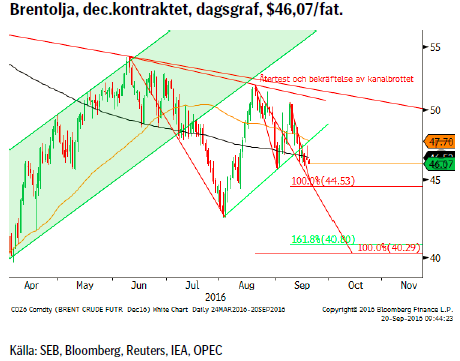 Marknaden befinner sig fortfarande i det kontrakterande intervall som vi förutspått ska hålla sig fram tills det informella OPEC-mötet i Alger den 26-28 september. Dock har prisbilden försvagats något i och med fallet ned under $47,00. Förra veckans rapport från EIA visade att antalet borrade men inte igångsatta källor (s.k. DUC’s, (drilled but uncompleted)) fortfarande är många och trots en viss nedgång det senaste halvåret ligger balansen på en historiskt hög nivå. Detta är källor som snabbt kan komma igång om priset skulle stiga.
Marknaden befinner sig fortfarande i det kontrakterande intervall som vi förutspått ska hålla sig fram tills det informella OPEC-mötet i Alger den 26-28 september. Dock har prisbilden försvagats något i och med fallet ned under $47,00. Förra veckans rapport från EIA visade att antalet borrade men inte igångsatta källor (s.k. DUC’s, (drilled but uncompleted)) fortfarande är många och trots en viss nedgång det senaste halvåret ligger balansen på en historiskt hög nivå. Detta är källor som snabbt kan komma igång om priset skulle stiga.
Konklusion: Sammantaget är utsikterna denna vecka något mer negativa än föregående vecka.
OBSERVATIONER
+ Spekulationer om ett produktionstak vid Algermötet.
+ Libysk export som förväntades komma igång i närtid lär återförsenas efter de senaste incidenterna mellan olika intressesfärer.
+ Situationen i Venezuela fortsätter att förvärras.
+ Iransk produktion verkar ha nått en platå.
+ US naturgas är fortsatt i stark efterfrågan.
– Fortsatt överutbud.
– Iransk export (inte produktion) på 5-års högsta.
– Saudisk produktion på rekordnivå (men bör säsongsmässigt snart börja minska då behovet av luftkonditionering avtar).
– Irakisk export förväntas öka ytterligare.
– Antalet amerikanska borriggar fortsätter att öka (och antalet borrade men ej igångsatta källor, DUC’s (drilled but uncompleted wells) på fortsatt hög nivå).
– Nigeriansk gerilla (Delta Avengers) har infört vapenvila.
– Lagren är fortsatt mycket stora (över 5-års snitt) men har de senaste veckorna fallit något.
– Det historiska säsongsmönstret talar för att en pristopp har satts under sommaren.
– Tekniskt så blir bilden än svagare om $45,70 bryts (vilket torde öppna upp för 44,53 som nästa stöd).
Tillgängliga certifikat:
BULL OLJA X1, X2 ,X4, X5, & X10 S
BEAR OLJA X1, X2, X4, X5 & X10 S
NICKEL LME 3M
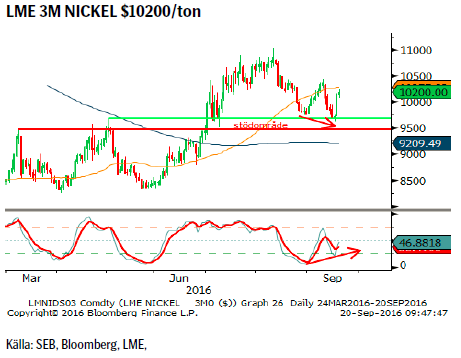 Till skillnad mot aluminium, koppar och nu även zink ser den kortsiktiga situationen för nickel bättre ut. Risken för produktionsstörningar/stopp i framför allt Filippinerna har fått priserna att stiga den senaste veckan. Den nya, sedan i våras, presidenten/regeringen har satt gruvsektorn och framför allt dagbrott under en betydligt hårdare miljöprövning och senare under veckan förväntas beslut om huruvida ytterligare produktion kommer att tvingas stänga tills strängare miljövillkor är uppfyllda.
Till skillnad mot aluminium, koppar och nu även zink ser den kortsiktiga situationen för nickel bättre ut. Risken för produktionsstörningar/stopp i framför allt Filippinerna har fått priserna att stiga den senaste veckan. Den nya, sedan i våras, presidenten/regeringen har satt gruvsektorn och framför allt dagbrott under en betydligt hårdare miljöprövning och senare under veckan förväntas beslut om huruvida ytterligare produktion kommer att tvingas stänga tills strängare miljövillkor är uppfyllda.
Konklusion: Avklarad korrektion? Gruvstängningar pga. miljökrav?
OBSERVATIONER
+ Fortsatt positiv vy på medellång – lång sikt så länge inte $9700/9480 passeras.
+ Filippinska hot om nickelgruvestängningar efter den miljörevision som förväntas offentliggöras senare denna vecka.
+ Enligt källor kan så mycket som upp till 8 % av världsproduktionen komma att beröras.
+ Ökad produktion men också ökad efterfrågan på rostfritt stål i Kina.
+ Tekniskt så föreligger ett misslyckat försök ned i stödområdet samt en möjlig positiv divergens (lägre botten i pris/högre botten i stochastic-indikatorn).
– Minskad kinesisk NPI (nickel pi giron) produktion (men också ökade lager av malm vilket gör att produktionen åter kan öka utan att pressa upp efterfrågan på malm).
– Lagren av raffinerat nickel var i augusti 252,000t att jämföra med 130,000t i augusti 2015.
– Falcondogruvan i Dominikanska republiken verkar enligt källor ha smugit igång igen efter Glencore sålde denna för några år sedan.
– En viss överproduktion kvarstår och förväntas öka något under både 2017 och 2018.
– LME lagren har ökat under sommaren (minskat marginellt på slutet).
Tillgängliga certifikat:
BULL NICKEL X1, X2, & X4 S
BEAR NICKEL X2 & X4
GULD
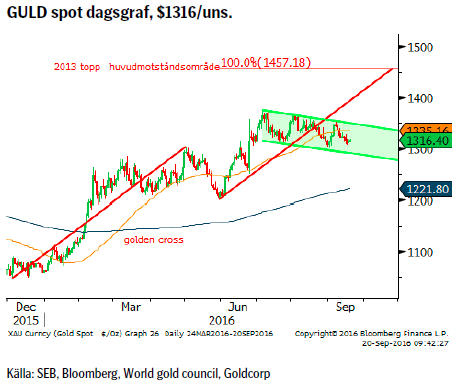 Guldet som förra veckan försökte men förvägrades kliva över den övre barriären i den möjliga ”tjurflaggan” avslutade veckan nära lägstanivån. Efter ett misslyckat försök på uppsidan är det vanligt att fokus svänger till den lägre barriären dvs. i detta fall ett test ned mot $1300 nivån.
Guldet som förra veckan försökte men förvägrades kliva över den övre barriären i den möjliga ”tjurflaggan” avslutade veckan nära lägstanivån. Efter ett misslyckat försök på uppsidan är det vanligt att fokus svänger till den lägre barriären dvs. i detta fall ett test ned mot $1300 nivån.
Konklusion: Fortsatt i konsolideringsfas men håll koll på BoJ & FOMC/FED på onsdag.
OBSERVATIONER
+ ETF-flödena var förra veckan blandade med utflöden ur guldfonder men inflöden i mindre guldgruvefonder.
+ Efterfrågan från världens 1,6miljarder muslimer kan komma att öka dramatiskt när en Sharia-standard för guld förväntas komma på plats under hösten.
+ FED’s obeslutsamhet avseende nästa räntehöjning.
+ Eventuella nya penningpolitiska stimulanser från ECB och Bank of Japan (BoJ ger besked på onsdag denna vecka).
+ Fallande guldproduktion (produktionen toppade 2015?).
+ Statsobligationer till ett värde av mer än $11 biljoner handlas nu till negativ ränta (och större delen av alla mellan 0 – 1 %).
+ Det viktiga motståndsområdet i $1400-området har ännu inte utmanats.
+ Tekniskt så kvarstår förutsättningarna för en så kallad ”tjurflagga”.
– Fortsatt positiva signaler för en starkare dollar.
– En minskning av nettolånga (långa positioner minskade med 18599 och korta ökade med 3848) spekulativa positionen som dock fortsatt är historiskt stor.
– Centralbankerna har sedan i våras successivt minskat sina inköp månad för månad.
– Rekylfasen i den negativa guld/silver-trenden ser nu att ha avslutats vilket riskerar att påverka guldpriset negativ (åtminstone relativt silver).
– Mycket tunga motstånd i $1400-området riskerar tynga.
– Tekniskt kvarstår risken för en djupare rekyl så länge inte priset klättrar upp över $1368.
Tillgängliga certifikat:
BULL GULD X1, X2, 4, 5 & 10 S
BEAR GULD X2, X4, X5 & X10 S
USD/SEK
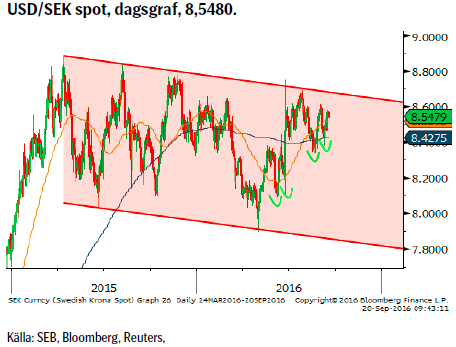 Dollarn fortsatte, efter den senaste högre botten, att förstärkas förra veckan (fredagen avslutades starkt efter högre än förväntad KPI från USA). Avseende innevarande vecka så står, FOMC mötet med åtföljande räntebesked på onsdag kväll kl. 20.00, i fokus. Sannolikheten för en höjning är enligt marknadens prissättning dock låg (en överraskande höjning skulle å andra sidan fånga marknaden ”felpositionerad” med en kraftigt stigande dollar som följd).
Dollarn fortsatte, efter den senaste högre botten, att förstärkas förra veckan (fredagen avslutades starkt efter högre än förväntad KPI från USA). Avseende innevarande vecka så står, FOMC mötet med åtföljande räntebesked på onsdag kväll kl. 20.00, i fokus. Sannolikheten för en höjning är enligt marknadens prissättning dock låg (en överraskande höjning skulle å andra sidan fånga marknaden ”felpositionerad” med en kraftigt stigande dollar som följd).
Konklusion: Fullt fokus på räntebeskedet från USA på onsdag kväll.
OBSERVATIONER
+ Räntedifferensen mellan USA och Sverige bör fortsätta att öka.
+ Högre amerikansk KPI (2015 ser också ut att ha givit de största löneökningarna i USA på många år).
+ Svensk ekonomi har börjat sakta in.
+ Dollarcykeln (sedan 1970-talet) pekar på en ny topp under 2017.
+ Positiv ränta i USA attraherar inflöden.
+ Den spekulativa långa nettopositioneringen i $-index är bara en fjärdedel av vad den var i början på året. Denna ökade dock ytterst marginellt under den senaste rapporteringsperioden.
+ JPY/SEK har brutit upp ur sin konsolidering och även EUR/SEK ser ut att vara på gång så kronförsvagningen kan komma att ge hävstång till ett brott av USD/SEK.
+ Tekniskt så är konsolideringen ett fortsättningsmönster talandes för en fortsättning av den tidigare uppåttrenden.
– Att FED gång efter annan har skjutit upp räntehöjningarna.
– FED vill inte ha en allt för stark dollar.
– Osäkerhet om presidentvalet.
– Den starka dollarn är en klar motvind för amerikanska exportföretag samt att den ger en deflationsimpuls som i sin tur gör FED än mer obeslutsam.
Tillgängliga certifikat:
BULL USDSEK X1 & X4 S
BEAR USDSEK X4 S
MAJS
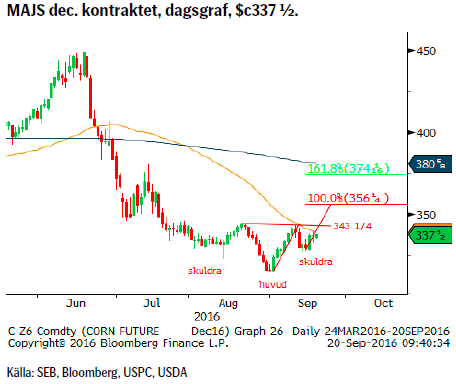 Är det värsta nu över efter det mycket kraftiga prisfallet sedan toppen i juni (som mest ned med 30 %)? Ja i alla fall i det kortare perspektivet så pekar flera faktorer mot att så kan vara fallet. Den spekulativa positionen, som var mycket stor, har förvänts i en lite nettokort position. Produktionen för innevarande år skrivs på flera ställen ned (även om lagren är fortsatt mycket stora). USA har även stämt Kina inför WTO pga. vad man anser vara otillbörliga subsidier till kinesiska bönder (vilket anses ha ökat kinesisk produktion och skadat amerikansk export).
Är det värsta nu över efter det mycket kraftiga prisfallet sedan toppen i juni (som mest ned med 30 %)? Ja i alla fall i det kortare perspektivet så pekar flera faktorer mot att så kan vara fallet. Den spekulativa positionen, som var mycket stor, har förvänts i en lite nettokort position. Produktionen för innevarande år skrivs på flera ställen ned (även om lagren är fortsatt mycket stora). USA har även stämt Kina inför WTO pga. vad man anser vara otillbörliga subsidier till kinesiska bönder (vilket anses ha ökat kinesisk produktion och skadat amerikansk export).
Konklusion: En möjlig botten kan ha satts på plats.
OBSERVATIONER
+ Spekulationer om en något lägre avkastning per hektar än vad den amerikanska jordbruksmyndigheten räknat med.
+ Den senaste WASDE rapporten pekade på lägre produktion, lägre lager och högre priser.
+ Stark amerikansk export bör krympa de stora lagren (som dock är de största sedan det sena 1980-talet).
+ Brasiliansk safrinha (andra)-skörden blev en besvikelse (den senaste revideringen i september kapade bort ytterligare 1,47m ton jämfört med augustiprognosen).
+ Kinesisk produktion skrivs ned pga. torrare förhållanden.
+ Efter att ha varit påfallande långa under framför allt juni så har den spekulativa långa nettopositionen sedan dess, i takt med att priset fallit, helt eliminerats (och vänts till en mindre kort netto position).
+ Tekniskt kan en s.k. inverterad huvud/skuldra-botten formation vara i görningen.
– Än så länge goda planteringsförutsättningar i södra Brasilien för första-sådden för 2016/17.
– Fortsatta rekordlager i framför allt USA.
– Gynnsamma priser i lokal valuta (BRL) indikerar en ökad förstamajssådd på bekostnad av sojabönor.
– Tekniskt negativt om 326 ¾ passeras på nedsidan.
Tillgängliga certifikat:
BULL MAJS X1 & X4 S
BEAR MAJS X1 & X4 S
OMXS30 (RENT TEKNISK UTBLICK)
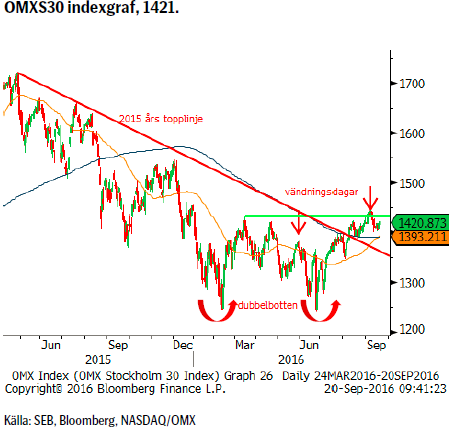 Den negativa vändningsdagen den sjätte september har än så länge levererat förväntat resultat dvs. fallande priser. Nedgången har dock skett under ordnade former vilket indikerar att denna är av korrektiv art. Det är dock ännu för tidigt att blåsa faran över och ett test ned i 1397 – 1370 området är fortfarande en realitet.
Den negativa vändningsdagen den sjätte september har än så länge levererat förväntat resultat dvs. fallande priser. Nedgången har dock skett under ordnade former vilket indikerar att denna är av korrektiv art. Det är dock ännu för tidigt att blåsa faran över och ett test ned i 1397 – 1370 området är fortfarande en realitet.
Konklusion: För att bibehålla en medelsiktigt positiv vy så bör området mellan 1397 – 1370 attrahera förnyat köpande (än så länge har inte stödområdet testats).
OBSERVATIONER
+ Priset ligger över både 55 och 233d mv.
+ Priset har brutit över rekyltoppen från mars, 1432 och därigenom brutit mönstret av fallande toppar.
+ 55d mv har en positiv lutning.
+ 55d mv är på väg att korsa 233d mv = ett troligt gyllene kors.
+ Långsiktig dubbelbotten vid 1240/46 stödet.
– Starka motstånd vid 1483.
– Kortsiktigare indikatorer har vänt till sälj.
– Befinner sig i korrektion efter den negativa vändningsdagen 6 september.
Tillgängliga certifikat:
BULL OMX X5 S
BEAR OMX X5 S
INFORMATION OM REKOMMENDATIONER
Denna publikation är ett marknadsföringsmaterial för SEBs certifikat-produkter. I och med den nya Marknadsmissbruksförordningen vilken trädde i kraft den tredje juli 2016 har vi inte längre möjlighet att inkludera investeringsrekommendationer rörande certifikat-produkterna.
UTVECKLING SENASTE VECKAN SAMT SEDAN ÅRETS BÖRJAN
[box]SEB Veckobrev Veckans råvarukommentar är producerat av SEB:s Commodities Sales desk och publiceras i samarbete och med tillstånd på Råvarumarknaden.se[/box]
KÄLLOR
Bloomberg, Reuters, SEB
VILLKOR
För varje enskilt certifikat/mini future finns Slutliga Villkor som anger de fullständiga villkoren. Slutliga Villkor finns tillgängligt på kurssidan för respektive certifikat/mini future på www.seb.se, Börs & finans, fliken Strukturerade placeringar.
RISKER
En sammanfattning av de risker som är förknippade med Börshandlade certifikat generellt finns i Produktbroschyren för respektive certifikat eller mini future som är tillgängligt på seb.se/cert respektive seb.se/mini. För en fullständig bild av riskerna behöver du ta del av SEB:s offentliggjorda Grundprospekt för Certifikat- och Warrantprogram som är publicerat på www.seb.se/cert respektive seb.se/mini.
DISCLAIMER
Detta marknadsföringsmaterial, framtaget av SEB:s Commodities Sales desk, har upprättats enbart i informationssyfte.
Även om innehållet är baserat på källor som SEB bedömt som tillförlitliga ansvarar SEB inte för fel eller brister i informationen. Den utgör inte oberoende, objektiv investeringsanalys och skyddas därför inte av de bestämmelser som SEB har infört för att förebygga potentiella intressekonflikter. Yttranden från SEB:s Commodities Sales desk kan vara oförenliga med tidigare publicerat material från SEB, då den senare hänvisas uppmanas du att läsa den fullständiga rapporten innan någon åtgärd vidtas.
Dokumentationen utgör inte någon investeringsrådgivning och tillhandahålls till dig utan hänsyn till dina investeringsmål. Du uppmanas att självständigt bedöma och komplettera uppgifterna i denna dokumentation och att basera dina investeringsbeslut på material som bedöms erforderligt. Alla framåtblickande uttalanden, åsikter och förväntningar är föremål för risker, osäkerheter och andra faktorer och kan orsaka att det faktiska resultatet avviker väsentligt från det förväntade. Historisk avkastning är ingen garanti för framtida resultat. Detta dokument utgör inte ett erbjudande att teckna några värdepapper eller andra finansiella instrument. SEB svarar inte för förlust eller skada – direkt eller indirekt, eller av vad slag det vara må – som kan uppkomma till följd av användandet av detta material eller dess innehåll.
Observera att det kan förekomma att SEB, dess ledamöter, dess anställda eller dess moder- och/eller dotterbolag vid olika tillfällen innehar, har innehaft eller kommer att inneha aktier, positioner, rådgivningsuppdrag i samband med corporate finance-transaktioner, investment- eller merchantbanking-uppdrag och/eller lån i de bolag/finansiella instrument som nämns i materialet.
Materialet är avsett för mottagaren, all spridning, distribuering mångfaldigande eller annan användning av detta meddelande får inte ske utan SEB:s medgivande. Materialet riktar sig inte till personer vars medverkan kräver ytterligare prospekt, registrerings- eller andra åtgärder än vad som följer av svensk rätt. Det åligger var och en att iaktta sådana restriktioner. Materialet får inte distribueras i eller till land där distribution kräver ovan nämnda åtgärder eller strider mot reglering i sådant land. Materialet riktar sig således inte till fysiska eller juridiska personer hemmahörande i USA eller i något annat land där publicering eller tillhandahållande av materialet är förbjudet eller strider mot tillämpliga bestämmelser i landet.
Oaktat detta får SEB tillåta omfördelning av materialet till utvald tredje part i enlighet med gällande avtal. Materialet får inte spridas till fysiska eller juridiska personer som är medborgare eller har hemvist i ett land där sådan spridning är otillåten enligt tillämplig lag eller annan bestämmelse.
Skandinaviska Enskilda Banken AB (publ) är ett publikt aktiebolag och står under tillsyn av Finansinspektionen samt de lokala finansiella tillsynsmyndigheter i varje jurisdiktionen där SEB har filial eller dotterbolag.
Analys
Tightening fundamentals – bullish inventories from DOE

The latest weekly report from the US DOE showed a substantial drawdown across key petroleum categories, adding more upside potential to the fundamental picture.

Commercial crude inventories (excl. SPR) fell by 5.8 million barrels, bringing total inventories down to 415.1 million barrels. Now sitting 11% below the five-year seasonal norm and placed in the lowest 2015-2022 range (see picture below).
Product inventories also tightened further last week. Gasoline inventories declined by 2.1 million barrels, with reductions seen in both finished gasoline and blending components. Current gasoline levels are about 3% below the five-year average for this time of year.
Among products, the most notable move came in diesel, where inventories dropped by almost 4.1 million barrels, deepening the deficit to around 20% below seasonal norms – continuing to underscore the persistent supply tightness in diesel markets.
The only area of inventory growth was in propane/propylene, which posted a significant 5.1-million-barrel build and now stands 9% above the five-year average.
Total commercial petroleum inventories (crude plus refined products) declined by 4.2 million barrels on the week, reinforcing the overall tightening of US crude and products.


Analys
Bombs to ”ceasefire” in hours – Brent below $70

A classic case of “buy the rumor, sell the news” played out in oil markets, as Brent crude has dropped sharply – down nearly USD 10 per barrel since yesterday evening – following Iran’s retaliatory strike on a U.S. air base in Qatar. The immediate reaction was: “That was it?” The strike followed a carefully calibrated, non-escalatory playbook, avoiding direct threats to energy infrastructure or disruption of shipping through the Strait of Hormuz – thus calming worst-case fears.

After Monday morning’s sharp spike to USD 81.4 per barrel, triggered by the U.S. bombing of Iranian nuclear facilities, oil prices drifted sideways in anticipation of a potential Iranian response. That response came with advance warning and caused limited physical damage. Early this morning, both the U.S. President and Iranian state media announced a ceasefire, effectively placing a lid on the immediate conflict risk – at least for now.
As a result, Brent crude has now fallen by a total of USD 12 from Monday’s peak, currently trading around USD 69 per barrel.
Looking beyond geopolitics, the market will now shift its focus to the upcoming OPEC+ meeting in early July. Saudi Arabia’s decision to increase output earlier this year – despite falling prices – has drawn renewed attention considering recent developments. Some suggest this was a response to U.S. pressure to offset potential Iranian supply losses.
However, consensus is that the move was driven more by internal OPEC+ dynamics. After years of curbing production to support prices, Riyadh had grown frustrated with quota-busting by several members (notably Kazakhstan). With Saudi Arabia cutting up to 2 million barrels per day – roughly 2% of global supply – returns were diminishing, and the risk of losing market share was rising. The production increase is widely seen as an effort to reassert leadership and restore discipline within the group.
That said, the FT recently stated that, the Saudis remain wary of past missteps. In 2018, Riyadh ramped up output at Trump’s request ahead of Iran sanctions, only to see prices collapse when the U.S. granted broad waivers – triggering oversupply. Officials have reportedly made it clear they don’t intend to repeat that mistake.
The recent visit by President Trump to Saudi Arabia, which included agreements on AI, defense, and nuclear cooperation, suggests a broader strategic alignment. This has fueled speculation about a quiet “pump-for-politics” deal behind recent production moves.
Looking ahead, oil prices have now retraced the entire rally sparked by the June 13 Israel–Iran escalation. This retreat provides more political and policy space for both the U.S. and Saudi Arabia. Specifically, it makes it easier for Riyadh to scale back its three recent production hikes of 411,000 barrels each, potentially returning to more moderate increases of 137,000 barrels for August and September.
In short: with no major loss of Iranian supply to the market, OPEC+ – led by Saudi Arabia – no longer needs to compensate for a disruption that hasn’t materialized, especially not to please the U.S. at the cost of its own market strategy. As the Saudis themselves have signaled, they are unlikely to repeat previous mistakes.
Conclusion: With Brent now in the high USD 60s, buying oil looks fundamentally justified. The geopolitical premium has deflated, but tensions between Israel and Iran remain unresolved – and the risk of missteps and renewed escalation still lingers. In fact, even this morning, reports have emerged of renewed missile fire despite the declared “truce.” The path forward may be calmer – but it is far from stable.
Analys
A muted price reaction. Market looks relaxed, but it is still on edge waiting for what Iran will do

Brent crossed the 80-line this morning but quickly fell back assigning limited probability for Iran choosing to close the Strait of Hormuz. Brent traded in a range of USD 70.56 – 79.04/b last week as the market fluctuated between ”Iran wants a deal” and ”US is about to attack Iran”. At the end of the week though, Donald Trump managed to convince markets (and probably also Iran) that he would make a decision within two weeks. I.e. no imminent attack. Previously when when he has talked about ”making a decision within two weeks” he has often ended up doing nothing in the end. The oil market relaxed as a result and the week ended at USD 77.01/b which is just USD 6/b above the year to date average of USD 71/b.

Brent jumped to USD 81.4/b this morning, the highest since mid-January, but then quickly fell back to a current price of USD 78.2/b which is only up 1.5% versus the close on Friday. As such the market is pricing a fairly low probability that Iran will actually close the Strait of Hormuz. Probably because it will hurt Iranian oil exports as well as the global oil market.
It was however all smoke and mirrors. Deception. The US attacked Iran on Saturday. The attack involved 125 warplanes, submarines and surface warships and 14 bunker buster bombs were dropped on Iranian nuclear sites including Fordow, Natanz and Isfahan. In response the Iranian Parliament voted in support of closing the Strait of Hormuz where some 17 mb of crude and products is transported to the global market every day plus significant volumes of LNG. This is however merely an advise to the Supreme leader Ayatollah Ali Khamenei and the Supreme National Security Council which sits with the final and actual decision.
No supply of oil is lost yet. It is about the risk of Iran closing the Strait of Hormuz or not. So far not a single drop of oil supply has been lost to the global market. The price at the moment is all about the assessed risk of loss of supply. Will Iran choose to choke of the Strait of Hormuz or not? That is the big question. It would be painful for US consumers, for Donald Trump’s voter base, for the global economy but also for Iran and its population which relies on oil exports and income from selling oil out of that Strait as well. As such it is not a no-brainer choice for Iran to close the Strait for oil exports. And looking at the il price this morning it is clear that the oil market doesn’t assign a very high probability of it happening. It is however probably well within the capability of Iran to close the Strait off with rockets, mines, air-drones and possibly sea-drones. Just look at how Ukraine has been able to control and damage the Russian Black Sea fleet.
What to do about the highly enriched uranium which has gone missing? While the US and Israel can celebrate their destruction of Iranian nuclear facilities they are also scratching their heads over what to do with the lost Iranian nuclear material. Iran had 408 kg of highly enriched uranium (IAEA). Almost weapons grade. Enough for some 10 nuclear warheads. It seems to have been transported out of Fordow before the attack this weekend.
The market is still on edge. USD 80-something/b seems sensible while we wait. The oil market reaction to this weekend’s events is very muted so far. The market is still on edge awaiting what Iran will do. Because Iran will do something. But what and when? An oil price of 80-something seems like a sensible level until something do happen.
-

 Nyheter3 veckor sedan
Nyheter3 veckor sedanStor uppsida i Lappland Guldprospekterings aktie enligt analys
-

 Nyheter4 veckor sedan
Nyheter4 veckor sedanBrookfield ska bygga ett AI-datacenter på hela 750 MW i Strängnäs
-

 Nyheter3 veckor sedan
Nyheter3 veckor sedanSilverpriset släpar efter guldets utveckling, har mer uppsida
-

 Nyheter3 veckor sedan
Nyheter3 veckor sedanUppgången i oljepriset planade ut under helgen
-

 Nyheter3 veckor sedan
Nyheter3 veckor sedanLåga elpriser i sommar – men mellersta Sverige får en ökning
-

 Analys3 veckor sedan
Analys3 veckor sedanVery relaxed at USD 75/b. Risk barometer will likely fluctuate to higher levels with Brent into the 80ies or higher coming 2-3 weeks
-

 Nyheter2 veckor sedan
Nyheter2 veckor sedanMahvie Minerals växlar spår – satsar fullt ut på guld
-

 Nyheter1 vecka sedan
Nyheter1 vecka sedanOljan, guldet och marknadens oroande tystnad



